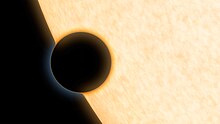The Hungarian Automated Telescope Network (HATNet) project is a network of six small fully automated "HAT" telescopes. The scientific goal of the project is to detect and characterize extrasolar planets using the transit method. This network is used also to find and follow bright variable stars. The network is maintained by the Center for Astrophysics | Harvard & Smithsonian.
HAT-P-6 also named Sterrennacht is a star in the constellation Andromeda, located approximately 895 light years or 274 parsecs away from the Earth. It is an F-type star, implying that it is hotter and more massive than the Sun. The apparent magnitude of the star is +10.54, which means that it can only be visible through the telescope. The absolute magnitude of +3.36 is brighter than the Sun's +4.83, meaning that the star itself is brighter than the Sun. A search for a binary companion star using adaptive optics at the MMT Observatory turned out negative.
ADS 16402 is a binary star system, composed of two sun-like stars located approximately 525 light-years away in the constellation Lacerta. It was first identified as a binary star by John Herschel in 1831. The two stars are separated by 11.26 arcseconds which leads to a projected separation of roughly 1500 astronomical units at the distance of ADS 16402. The star system is estimated to be 1.9 ± 0.6 billion years old. The secondary star ADS 16402 B is also designated HAT-P-1.
WASP-11/HAT-P-10 is a binary star. It is a primary main-sequence orange dwarf star. Secondary is M-dwarf with a projected separation of 42 AU. The system is located about 424 light-years away in the constellation Aries.
HAT-P-9 is a magnitude 12 F star approximately 1500 light years away in the constellation Auriga. A search for a binary companion star using adaptive optics at the MMT Observatory was negative.
HAT-P-4 is a wide binary star consisting of a pair of G-type main-sequence stars in the constellation of Boötes. It is also designated BD+36°2593.

HAT-P-11b is an extrasolar planet orbiting the star HAT-P-11. It was discovered by the HATNet Project team in 2009 using the transit method, and submitted for publication on 2 January 2009.
HAT-P-7 is a F-type main sequence star located about 1088 light-years away in the constellation Cygnus. The apparent magnitude of this star is 10.5, which means it is not visible to the naked eye but can be seen with a small telescope on a clear dark night.

HAT-P-14b, officially named Sissi also known as WASP-27b, is an extrasolar planet located approximately 224.2 ± 0.6 parsecs (731.2 ± 2.0 ly) away in the constellation of Hercules, orbiting the 10th magnitude F-type main-sequence star HAT-P-14. This planet was discovered in 2010 by the HATNet Project using the transit method. It was independently detected by the SuperWASP project.
HAT-P-33 is a late-F dwarf star. It is orbited by a planet called HAT-P-33b. A search for a binary companion star using adaptive optics at the MMT Observatory was negative.
Kepler-17 is a main-sequence yellow dwarf star that is much more active than the Sun with starspots covering roughly 6% of its surface. Starspots are long-lived, with at least one persisting for 1400 days.
HAT-P-24 is an F8 dwarf star about 413 parsecs away. A planet was discovered with the transit method by the HATNet Project in 2010. HAT-P-24b, is a typical hot Jupiter orbiting in only 3 days.
HAT-P-17 is a K-type main-sequence star about 92.4 parsecs (301 ly) away. It has a mass of about 0.857 ± 0.039 M☉. It is the host of two planets, HAT-P-17b and HAT-P-17c, both discovered in 2010. A search for a binary companion star using adaptive optics at the MMT Observatory was negative. A candidate companion was detected by a spectroscopic search of high-resolution K band infrared spectra taken at the Keck observatory.
HAT-P-26 is a K-type main-sequence star about 466 light-years away. A survey in 2015 did not find any stellar companions in orbit around it, although a red dwarf companion with a temperature 4000+100
−350 K is suspected on wide orbit.
Kepler-411 is a binary star system. Its primary star Kepler-411A is a K-type main-sequence star, orbited by the red dwarf star Kepler-411B on a wide orbit, discovered in 2012.
Kepler-410 is a binary star system. Its primary star, also known as Kepler-410A, is a F-type subgiant star, orbited by the orange dwarf star Kepler-410B on a wide orbit. The companion star was discovered in 2012.

K2-25 is a young red dwarf star located in the Hyades cluster. There is a single known Neptune-sized planet in a 3.5 day orbit.



